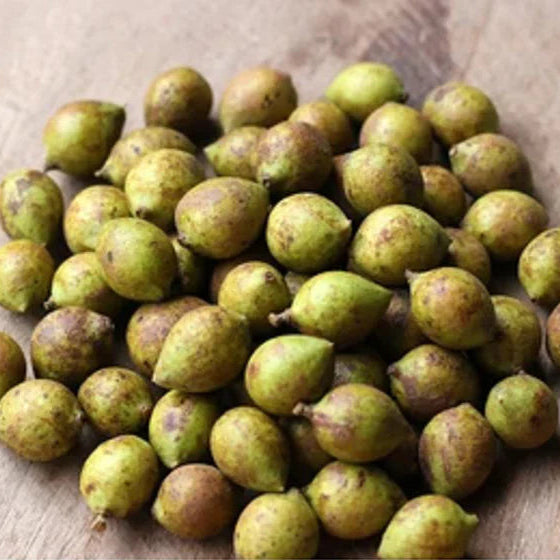Love it? Add to your wishlist
Your favorites, all in one place. Shop quickly and easily with the wishlist feature!
[message]
[title]
[message]

Veliyath Gardens
Couldn't load pickup availability
Pongo Fruit Plant: Cambodia’s Tangy Treasure Rooted in Tropical Wisdom
Botanical Name: Pongo sp.
Common Names: Pongo Fruit, Pongro, Cambodian Tangy Fruit
Origin: Cambodia (also found in parts of Thailand and Vietnam)
An Ancient Taste from Southeast Asia’s Heart
Hailing from the lush tropical landscapes of Cambodia, the Pongo Fruit Plant—locally known as Pongro—has been part of Southeast Asian culinary and cultural traditions for centuries. Often found in traditional Cambodian home gardens and roadside groves, the Pongo Fruit is cherished for its captivating sweet-and-sour flavor, striking appearance, and remarkable adaptability. This unique fruit is slowly gaining admiration among fruit lovers across Southeast Asia and beyond, including Thailand and Vietnam, where similar species are locally appreciated.
The Taste That Captures Cultures
Pongo Fruit offers a flavor profile that is both nostalgic and refreshing. The fruit has a smooth, glossy skin—often tinged with golden or light green hues when ripe—and conceals a translucent pulp. The taste is distinctly tangy with subtle sweetness, delivering a tropical zest that lingers on the palate. Its sensory appeal is akin to a cross between tamarind and a mild citrus, making it exceptionally versatile in both traditional and modern kitchens.
In Cambodian villages, the fruit is often enjoyed fresh during the peak of its season. Local markets display baskets filled with Pongo fruits, their scent inviting and tartly aromatic. Whether sprinkled with salt and chili for a quick snack, or fermented into tangy pickles that accompany rice dishes, this fruit seamlessly integrates into daily life.
Cultural Significance and Local Uses
The Pongo Fruit has played a notable role in Cambodian culture as both a culinary staple and a medicinal aid. In rural areas, it’s not uncommon to see children plucking the ripe fruits from backyard trees or elderly family members preparing it into traditional dishes.
In local folk medicine, the fruit has been used for treating indigestion and minor skin irritations. Its cooling nature made it a remedy for fever and heat exhaustion. Moreover, villagers used crushed leaves of the tree as a poultice for wounds, and the bark was sometimes steeped in decoctions for its purported antimicrobial properties.
Nutritional Strength in a Small Package
Though modest in size, the Pongo Fruit is abundant in essential nutrients. It is naturally rich in:
Vitamin C – A powerful immunity booster that helps protect skin health, accelerate healing, and combat seasonal illnesses.
Antioxidants (including naringenin and naringin) – These help neutralize oxidative stress, reduce inflammation, and may have anti-aging and heart-protective properties.
Dietary Fiber – Promotes digestive health and supports weight management.
Potassium and Copper – Vital for muscle function, cardiovascular health, and maintaining energy levels.
Emerging research suggests that compounds in Pongo Fruit may exhibit antibacterial, antifungal, and even anti-cancer potential. Though more scientific exploration is needed, its long-standing use in traditional diets hints at deeply rooted health wisdom.
Culinary Magic in Every Bite
The Pongo Fruit offers a burst of tropical brightness to a wide array of dishes. It is a culinary treasure in Cambodian kitchens and gaining recognition in gourmet circles for its versatility:
Fresh Consumption – Simply sliced and enjoyed raw, it offers a palate-cleansing, refreshing experience.
Pickled Delicacies – The fruit’s tang lends itself beautifully to traditional pickles, especially when mixed with vinegar, chili, and garlic.
Flavor Enhancer – Its juice can substitute lemon or lime in drinks, marinades, or even desserts.
Culinary Creativity – Chefs use it to balance flavors in salads, seafood dishes, or to infuse sauces with a tropical twist.
Growing and Caring for the Pongo Fruit Plant
This plant is an ideal companion for those in tropical or sub-tropical regions. With moderate maintenance needs, it thrives in warm, sun-drenched environments and is relatively easy to care for.
Soil Preference: Well-drained, slightly acidic to neutral soil.
Sunlight: Full sun to partial shade.
Watering: Requires regular watering during dry months, but once established, shows good drought resistance.
Time to Fruiting: Usually begins to fruit in 3 to 4 years under ideal conditions.
Growth Habit: Medium-sized tree with lush foliage that provides shade and attracts pollinators.
The plant also contributes to a garden’s ecosystem by enhancing soil quality and supporting local biodiversity. Its attractive canopy and steady yield make it an aesthetically pleasing and functional addition to any garden.
Preservation and Storage Traditions
Traditionally, the fruit is sun-dried or pickled to preserve its tangy character. In Cambodian homes, Pongo Fruit pickles are often stored in ceramic jars, passed down through generations for use in festivals or family feasts. The fruit also stores well in the refrigerator for up to a week when fresh, and its juice can be frozen for later use in sauces or beverages.
Adding Pongo to Your Lifestyle
Incorporating Pongo Fruit into your life means embracing a lifestyle rooted in health, flavor, and tradition. It offers a natural, flavorful way to:
Add zest to meals
Strengthen immunity naturally
Reduce dependency on artificial flavoring agents
Support digestive health with regular consumption
Enjoy culinary traditions from Southeast Asia at your own table
Its unique tang and versatility make it more than just another tropical fruit—it becomes a staple, an experience, and a connection to culture and nature.
Why Choose Pongo Fruit Plant from Veliyath Gardens?
At Veliyath Gardens, we are committed to bringing you not just rare plants, but meaningful additions to your garden and life. The Pongo Fruit Plant reflects our mission—to reconnect people with the healing, nourishing power of nature. This isn’t just a plant; it’s a bridge to ancient traditions, flavorful moments, and better health.
Make the Pongo Fruit Plant a part of your garden story. Let its lush leaves and tangy fruits remind you daily of the joys of nature, the wisdom of tradition, and the beauty of slow, meaningful growth.
Veliyath Gardens welcomes you to experience this tropical treasure—grown with care, delivered with love.
Soil Preference: Well-drained, slightly acidic to neutral soil.
Sunlight: Full sun to partial shade.
Watering: Requires regular watering during dry months, but once established, shows good drought resistance.
Vitamin C – A powerful immunity booster that helps protect skin health, accelerate healing, and combat seasonal illnesses.
Antioxidants (including naringenin and naringin) – These help neutralize oxidative stress, reduce inflammation, and may have anti-aging and heart-protective properties.
Dietary Fiber – Promotes digestive health and supports weight management.
The Pongo Fruit has played a notable role in Cambodian culture as both a culinary staple and a medicinal aid. In rural areas, it’s not uncommon to see children plucking the ripe fruits from backyard trees or elderly family members preparing it into traditional dishes.
In local folk medicine, the fruit has been used for treating indigestion and minor skin irritations.


